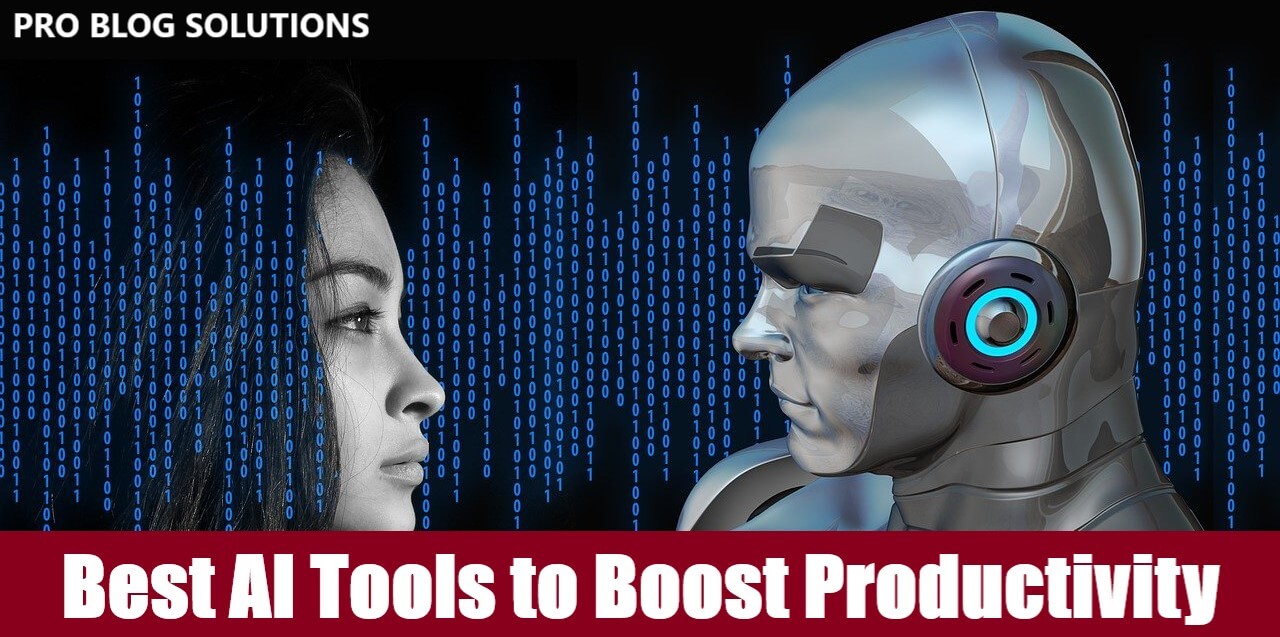As a tech and productivity enthusiast, I’ve explored and leveraged some of the top-rated and best AI tools of 2025.
In the ever-evolving landscape of technology, artificial intelligence (AI) has emerged as a powerful force, transforming how we work and live.
Do you remember a time when half the world was worried that artificial intelligence would take over the world and rule humankind? From software development to business intelligence, AI is everywhere you look!
While most of the capabilities of artificial intelligence (AI) that we see in movies like Terminator and I Robot are still a distant reality, AI has evolved to a genuinely commendable level now.
In fact, with the proper AI implementation, you can now say goodbye to menial business tasks and focus on the more essential aspects of growing your business holistically.
AI productivity tools are here to stay, so you might as well be an early bird and get on the list of companies using artificial intelligence to augment their business.
Numerous AI tools in the market, supported by big data and machine learning, can help you cut your operational costs, improve the overall productivity of your employees and your business, and increase the satisfaction of all your stakeholders.
In this article about the best AI tools for productivity, we will take a moment to understand the relevance of AI tools and machine learning in business processes.
We will also explore some artificial intelligence tools that can help you streamline your business processes and improve your overall business productivity.
I will take you on a personal journey through my experiences with these top-rated productivity AI tools, sharing personal anecdotes, insights, and detailed explanations for each one.
Types of AI Tools for Productivity in 2025
When looking at generative AI tools, you'll find a lot of different choices for different applications:
- Text generation tools for stories, articles, and dialogue.
- Image generation tools for new and visually appealing images based on existing patterns or styles.
- Music generation tools for melodies, harmonies, and even entire compositions.
- Video generation tools for creating or enhancing videos.
- Design and creativity tools for designs, artwork, or other artistic elements.
- Game content generation tools for creating game levels, characters, or other elements to enhance gameplay.
- Data augmentation tools for augmenting or enhancing existing datasets and improving training for AI models.
- 3D model generation tools for generating models based on specified parameters or examples.
How Can AI Tools Help You to Be More Productive in 2025?
In addition to helping you be more productive, AI tools can also be used for:
Automating tasks. You can automate repetitive tasks using AI tools, allowing you to focus on more critical tasks.
Providing insights. AI tools can help you better understand your data and make better decisions.
Personalizing your experience. AI tools can enhance your user experience, making it easier to discover the tools and information you need.
Making recommendations. Artificial intelligence can help you save time and effort by making recommendations based on your past behaviour.
What are the Benefits of Using AI Tools for Productivity?
Artificial intelligence tools can improve productivity in the following ways:
- Increased productivity. You can free up more time by automating tasks using AI tools.
- Improved accuracy. AI tools can improve the accuracy of your work and catch errors you might have otherwise missed.
- Enhanced creativity. It’s possible to be more creative by using AI tools to generate new ideas and insights.
- Improved decision-making. By providing insights into your data, AI tools can assist you in making better decisions.
What are the Challenges of Using AI Tools for Productivity?
Using AI tools for productivity can present some challenges, including:
Interpretability. Understanding how AI tools make their decisions can be challenging, which makes them hard to trust.
Accuracy. It is possible for AI tools to make mistakes, and they are not always accurate.
Bias. The results of AI tools can be inaccurate or unfair due to bias.
Cost. Businesses, especially, can find AI tools expensive.
How to Choose the Best AI Tool for Your Needs?
It is essential to consider a few factors when choosing an AI tool for productivity, including:
Accuracy of the tool. Does the tool have a high level of accuracy?
What you need. In what ways will the tool be helpful to you?
The budget you have. What is your budget for the tool?
Features of the tool. Which features are important to you?
Easy of use: Is the tool easy to use?
Top-Rated Best Productivity AI Tools in 2025

When utilizing AI tools for productivity, balancing relying on technology and using your own judgment is crucial.
While these tools can be incredibly helpful in streamlining processes and generating output, it is crucial to stay focused on the ultimate goal of your project.
Additionally, spending too much time inputting prompts into the AI or generating excessive output is easy.
This can make editing and manipulating the material challenging to create a cohesive final product.
Honoring your editing and cutting skills is essential to overcome these challenges and succeed.
You can create a polished and concise result by eliminating unnecessary material and refining the AI's output.
Remember, productivity is not just about utilizing AI tools but also about effective time management.
By tracking and analyzing where and how much time employees spend at work, you can identify areas for improvement and optimize productivity.
1. ChatGPT Plus
When I first encountered ChatGPT Pro, developed by OpenAI, I was sceptical about its abilities.
However, as I delved into the tool, it quickly became an indispensable companion for my writing endeavours.
Its advanced AI-powered writing assistance capabilities, including personalized suggestions and context-aware insights, have transformed how I draft, edit, and optimize content.
With ChatGPT Pro, my writing productivity has soared, and the quality of my work has significantly improved.
2. Jarvis
Jarvis is an AI-powered virtual assistant that has become my go-to tool for managing tasks and organizing my daily routines.
Jarvis adapts to my preferences through machine-learning algorithms, making it an efficient and intuitive assistant.
From scheduling appointments to sending emails, Jarvis has simplified and streamlined my workflow, saving me precious time and energy.
3. Grammarly Premium
As someone who places great emphasis on clear and effective communication, Grammarly Premium has been a game-changer.
With its AI-driven writing assistance, this tool goes beyond grammar and spell-checking.
It offers advanced suggestions, tone adjustments, and even genre-specific writing assistance.
The detailed insights and recommendations have helped refine my writing style and deliver polished, error-free content.
4. GPT-3 Apps
Project management is a vital aspect of my work, and integrating GPT-3 capabilities into project management platforms has revolutionized how I collaborate and manage tasks.
These AI-enhanced tools automate task assignment, resource allocation, and project status tracking processes.
I’ve witnessed increased efficiency, improved team coordination, and enhanced project outcomes by leveraging AI's power.
5. AI-Powered Email Management
Like many professionals, my inbox often felt overwhelming and time-consuming.
However, I gained control over my email workflow with AI-powered email management tools such as Superhuman and Hey.
These tools utilize machine learning to prioritize and categorize emails automatically, allowing me to focus on crucial messages while reducing email clutter.
The time saved and increased productivity have been remarkable.
6. Time-Tracking AI Apps
As someone constantly striving for optimal time management, I find AI-based time-tracking apps like RescueTime and Toggl Track invaluable.
These apps monitor my activities, provide insightful analytics, and help identify time-wasting habits.
Armed with these data-driven insights, I’ve made more informed decisions, optimized my daily routines, and achieved greater productivity.
7. AI-Enhanced Customer Support
In my interactions with various companies, I’ve noticed the rise of AI-driven customer support solutions such as Zendesk AI and Freshdesk AI.
These tools handle routine customer queries and support tickets with speed and accuracy.
The instant responses provided by AI-powered support systems have impressed customers and freed up valuable time for support teams to tackle more complex issues, resulting in improved customer satisfaction.
8. AI-Language Translation
As a global society, effective communication across language barriers is essential.
AI-powered language translation tools, like DeepL and Google Translate, have become my trusted companions in overcoming these barriers.
With their advanced AI algorithms, these tools provide accurate and quick translations, facilitating seamless communication across languages.
Whether collaborating with international colleagues or travelling to different countries, AI language translation has expanded my horizons and enhanced my productivity.
9. AI-Backed Personal Assistants
The advent of virtual personal assistants like Amazon’s Alexa, Apple’s Siri, and Google Assistant has revolutionized how we interact with technology in our daily lives.
These AI-driven assistants have become integral to my routine, helping me set reminders, answer queries, and control smart home devices.
With their continuous learning capabilities and voice recognition, these personal assistants have transformed my home into a seamlessly connected environment, boosting efficiency and productivity.
10. AI-Driven Sales and Marketing Automation
AI-powered tools like SalesforceEinstein and HubSpot’s AI capabilities have reshaped the landscape in sales and marketing.
These tools offer insights, automate processes, and personalize marketing content, resulting in higher conversion rates and more effective sales strategies.
My experiences with these AI-driven solutions have opened my eyes to AI's immense potential for driving business success and empowering marketing professionals.
11. AI-Driven Content Creation
AI-powered content creation tools, such as Articoolo and Copy.ai, have emerged as valuable resources for content creators.
These tools leverage natural language processing and machine learning algorithms to generate high-quality articles, blog posts, and social media captions.
These tools save time by providing topic suggestions, generating content outlines, and writing paragraphs. They also inspire creativity and enhance the overall content-creation process.
12. AI-Powered Data Analysis
Data analysis plays a crucial role in decision-making across various industries.
AI-powered data analysis tools, like Tableau and IBM Watson Analytics, streamline the process of extracting insights from complex datasets.
With their ability to identify patterns, trends, and correlations, these tools empower businesses to make data-driven decisions more efficiently.
From market research to financial analysis, AI-driven data analysis has become a powerful ally in harnessing the potential of big data.
13. AI-Enabled Virtual Meetings
With the rise of remote work and global teams, AI-enabled virtual meeting tools have become essential for seamless collaboration.
Platforms like Zoom and Microsoft Teams incorporate AI features such as background noise cancellation, intelligent transcription, and automated meeting scheduling.
These AI capabilities enhance communication, productivity, and engagement during virtual meetings, bridging geographical gaps and fostering effective teamwork.
14. AI-Powered Personalized Learning
Education is undergoing a transformation with AI-powered personalized learning platforms like Khan Academy and Duolingo.
These tools adapt to learners’ abilities, preferences, and progress, offering personalized recommendations, targeted exercises, and adaptive assessments.
By leveraging AI algorithms, personalized learning platforms provide tailored educational experiences, making learning more engaging, efficient, and effective.
15. AI-Enhanced Healthcare
In the healthcare industry, AI has the potential to revolutionize patient care.
AI-powered diagnostic tools, such as IBM Watson for Oncology and Aidoc, assist healthcare professionals in accurately diagnosing diseases and identifying potential treatment options.
Additionally, AI-enabled wearable devices and health monitoring apps, like Apple Watch and Fitbit, provide real-time health data, empowering individuals to proactively manage their well-being.
16. AI-Driven Cybersecurity
As cyber threats evolve, AI-driven cybersecurity tools have become indispensable for protecting sensitive information and digital assets.
Tools like Darktrace and Cylance utilize AI algorithms to detect and mitigate cyber threats in real-time.
It will also enhance organizations’ ability to identify anomalies, prevent breaches, and respond swiftly to security incidents.
17. AI-Powered Financial Planning
AI-powered financial planning tools like Wealthfront and Betterment provide personalized investment advice, automated portfolio management, and intelligent financial goal-setting.
These tools leverage AI algorithms to analyze market trends, risk profiles, and individual financial circumstances.
It enables individuals to make informed investment decisions and optimize their wealth management strategies.
18. AI-Driven Virtual Reality
AI and virtual reality (VR) have converged to create groundbreaking experiences.
AI-powered VR tools, like Oculus and HTC Vive, deliver immersive simulations, interactive storytelling, and realistic virtual environments.
These tools have applications in industries ranging from gaming and entertainment to education and training, revolutionizing how we experience and interact with virtual worlds.
19. Voice Assistants for Smart Homes
Integrating AI into voice-activated smart home devices, such as Amazon Echo with Alexa and Google Nest with Google Assistant, has transformed how we interact with our living spaces.
These AI-enabled voice assistants control smart devices, provide weather updates, play music, and even order groceries with simple voice commands.
The convenience and hands-free operation offered by these AI-powered voice assistants have simplified everyday tasks and made our homes more innovative and efficient.
20. AI-Backed Social Media Management
Managing a social media presence can be a time-consuming task.
AI-powered social media management tools, like Hootsuite and Sprout Social, automate scheduling, content curation, and analytics.
These tools leverage AI algorithms to suggest optimal posting times, recommend engaging content, and analyze social media performance, allowing businesses and individuals to maximize their social media impact with minimal effort.
10+ More Notable AI Tools to Boost Your Productivity in 2025:
In today's fast-paced digital world, staying productive is essential for professionals and individuals.
Fortunately, advancements in artificial intelligence (AI) have produced a range of innovative tools designed to enhance productivity and streamline daily tasks.
From writing assistance to time management and social media optimization, these AI-powered tools are transforming the way we work and helping us achieve more in less time.
Otter.ai
Otter.ai is an AI transcription tool that automatically converts speech to text.
It's beneficial for meetings, interviews, and note-taking. Otter.ai provides real-time transcription, allowing you to search, highlight, and review important information later.
It saves time by eliminating manual note-taking and facilitates easy sharing and collaboration.
Calendly
Calendly is an AI scheduling tool that eliminates the back-and-forth of finding mutually convenient meeting times.
It syncs with your calendar and allows others to book time slots based on your availability.
Calendly reduces the time spent on scheduling meetings and helps you stay organized.
Fliki
Fliki, with 4.19 million monthly visits, is a text-to-video tool that helps you create stunning content with AI voices in just 2 minutes.
It’s an excellent tool for small business owners and marketers who want to create engaging video content but may not have the time or resources to do so.
With Fliki, you can transform blog articles into videos, use lifelike text-to-speech voices, and create videos in 75+ languages and 100+ dialects.
This makes it a versatile tool for reaching diverse audiences. Fliki has a free version. Paid tiers start from $8 per month.
Trello
Trello is a project management tool that utilizes AI to streamline task management.
It uses boards, lists, and cards to help you organize and prioritize your projects and tasks.
Trello's AI capabilities help automate repetitive tasks, assign due dates, and provide insights into team productivity.
RescueTime
RescueTime is an AI-powered productivity tool that helps you track and analyze your digital activities.
It monitors your time on different applications, websites, and documents, providing detailed reports on your productivity.
RescueTime offers insights and recommendations to help you manage your time more effectively.
Evernote
Evernote is a versatile note-taking tool that leverages AI to organize and manage your notes efficiently.
It allows you to capture text, images, web articles, and handwritten notes, which are then indexed and searchable.
Evernote's AI capabilities include intelligent search, document scanning, and even suggested tags, making finding and retrieving information easier.
With these AI tools, you can harness the power of artificial intelligence to supercharge your productivity, saving valuable time and energy.
Solve Anything with ChatGPT
ChatGPT is an extensive language model chatbot developed by OpenAI and launched on November 30, 2022.
It is trained on a massive dataset of text and code and can generate text, translate languages, write different kinds of creative content, and answer your questions informally.
In less time, ChatGPT has learned to perform many kinds of tasks, including:
- Following instructions and completing requests thoughtfully.
- Answering questions in a comprehensive and informative way, even if they are open-ended, challenging, or strange.
- Generating different creative text formats of text content, like poems, code, scripts, musical pieces, email, letters, etc.
ChatGPT is a powerful tool for various purposes, such as customer service, education, and entertainment.
It has the potential to revolutionize the way we interact with computers.
Generate User Personas With Userdoc AI
With Userdoc AI, you can generate detailed user personas that reflect the characteristics and needs of your target users.
Test User Interfaces With Synthetic Users
Synthetic Users is an innovative AI-powered user research tool.
You can use it to create scenarios, test user interfaces, evaluate product usability, and gain insights into how users interact with your solutions.
Fronty to Convert Image to HTML
Fronty uses artificial intelligence to generate HTML and CSS code from an image.
This allows you to turn static wireframes and layouts into dynamic, interactive websites in minimal time.
You can also optimize the final product in your editor without Fronty code.
Writesonic to Write Anything
Writesonic is a powerful AI-based tool capable of generating different types of content.
It can be used to create texts for blogs, fill all pages of the application with micro-texts, reply to mail, and create newsletters for users.
In addition, you can perfect your content using AI-based editing tools such as Paraphraser, Expander, and Shortener.
Generate Codes With Replit
Replit is a robust platform that generates code snippets and helps developers with coding tasks.
Of course, a UX designer doesn’t need to write code, but you need to know how the code works.
That way, you can ask for edits and talk to the developer in the same language.
Midjourney to Generate Art for Projects
Midjourney is an online tool to convert text to images.
You will easily find ways to use this tool in your daily work. For example, with Midjourney, you can create a mood board from AI-generated images with relative ease.
It can then be used as a prompt for designers to create visuals.
Generates Videos With Synthesia
Synthesia is an advanced artificial intelligence technology that creates realistic videos using virtual actors and customizable scripts.
It is used by companies such as Google, Nike, and Reuters to create video content.
Generate Avatars With Starryai
Starryai is an AI tool that creates personalized avatars by bringing digital characters to life.
You can make five AI-generated avatars per day for free. You can use your AI-generated avatars as profile photos for your social media, on your websites, on business cards, and on sticker merchandise.
SlidesAI.io to Create Presentation Slides
Say goodbye to tedious, manual slide creation. Let the AI create professional, engaging slides quickly from any text.
SlidesAI.io is an advanced platform that automates the creation of professional PowerPoint presentations.
Simply paste your text into SlidesAI, and a presentation will automatically be created for you.
Summarize Presentation With SlideSpeak
Upload a PowerPoint file, and the SlideSpeak AI-based tool will generate a summary and answer presentation questions by analyzing visual content such as images, diagrams, or infographics.
For now, SlideSpeak is free. This might change in the future, but you're more than welcome to use their platform free of charge.
Remini to Edit Pictures & Videos
Remini is an artificial intelligence-based photo and video editing tool that improves the quality of images.
Using this tool, you can enhance details, colours, and clarity. Visual content will become brighter and more transparent.
Its transformative technology gives your low-quality visuals a stunning HD upgrade.
You can restore old photos to incredible detail and elevate your content professionally.
Summarize Notes With Summarizing Tool
The online text summarizer helps summarize the content for educational or official use.
This summarizing tool uses the latest AI technology to provide an accurate and efficient article overview.
This summary generator doesn’t change the meaning of the original content. The online summarizing tool has significant features, which include:
| Precise Summary | Uses Advanced AI to Summarize |
| Versatile Results | General, Bullets, & Best Line Summary |
| Multilingual | 8 Different Languages |
| 100% Free | Unlimited Text Summarization |
Generate Music With Soundraw
Soundraw is an AI tool that generates original music tracks based on user preferences and inputs.
Select the tune’s genre, mood, and duration; AI will do the rest for you.
11 More AI Tools to Boost Productivity in 2025
1. Jasper
Jasper is an AI-powered writing assistant that understands context and tone.
It assists content creators, bloggers, and marketers by generating high-quality content suggestions that align with the intended style and message.
2. WriteSonic
WriteSonic is a versatile AI tool that generates various types of content, from blog posts to ad copies.
It has an intuitive interface where users input prompts to receive well-structured and engaging content.
3. ChatGPT
ChatGPT, developed by OpenAI, excels in creating natural-sounding text.
It's invaluable for brainstorming ideas, generating content, and crafting conversational dialogue. ChatGPT showcases AI's ability to mimic human text creation.
4. Scalenut
Scalenut assists writers in overcoming writer's block by generating ideas, outlines, and complete articles across different niches.
It's a handy tool for jumpstarting the creative process and producing high-quality content efficiently.
5. Quillbot
Quillbot enhances writing clarity and coherence by offering paraphrasing suggestions, vocabulary enhancements, and grammar corrections.
It's an excellent tool for refining content and ensuring it communicates effectively.
6. Illustroke
Illustroke, though primarily an illustration tool, can complement content writing by generating visual concepts from prompts.
It transforms rough ideas into polished visuals, adding a creative element to the content.
7. Midjourney
Midjourney is designed for graphic design but can benefit content writers by suggesting colour palettes, fonts, and layouts.
It streamlines the design process and fosters a collaborative approach to content creation.
8. Pictory AI
Features: Pictory AI enhances content by suggesting relevant images that match the tone and context. This tool adds visual appeal to written material, making it more engaging for readers.
9. Originality.ai
Originality.ai safeguards content creators against plagiarism by scanning written material and cross-referencing it with an extensive database.
It ensures authenticity and proper citation, a crucial factor in maintaining credibility.
10. Copy.ai
Copy.ai is a versatile tool that assists in generating a variety of content, including blog posts, headlines, social media copy, and more.
It's tailored to meet the diverse content needs of writers and marketers.
11. ContentBot
ContentBot specializes in generating blog posts and articles on various topics.
It's handy for content marketers and bloggers looking to scale their content creation efforts.
These AI tools cater to different facets of content writing, offering a blend of creativity, efficiency, and accuracy.
By integrating these tools into your content creation process, you can unlock new productivity levels and produce content that captivates audiences.
AI Tools for Video Editing to Boost Your Productivity in 2025:
In the realm of video editing, artificial intelligence has paved the way for transformative advancements.
AI tools designed for video editing streamline processes, enhance visual appeal, and elevate the overall quality of video content.
These tools are a boon for creators, enabling them to produce captivating videos more efficiently.
Let's explore a range of AI tools tailored for video editing, each offering distinct features to revolutionize the editing process:
1. Synthesia
Synthesia employs AI-generated avatars to create lifelike video content.
It's a game-changer for businesses and creators who want to communicate information through engaging and visually appealing avatars.
2. Magisto
Magisto utilizes AI to analyze video clips and photos, automatically generating compelling video content.
It simplifies editing by transforming raw footage into polished videos with minimal effort.
3. Lumen5
Lumen5 is designed for content creators who want to turn text into captivating video content.
It uses AI to convert written content into dynamic videos, making it ideal for sharing on social media platforms.
4. Clipchamp
Clipchamp combines AI-driven tools with a user-friendly interface, enabling users to edit videos effortlessly.
It provides automatic video creation, text-to-speech, and stock footage integration.
5. InVideo
InVideo offers AI-powered tools for quick and efficient video editing.
It provides access to a library of templates, stock footage, and effects, making it a versatile solution for various video editing needs.
6. Adobe Premiere Pro
Adobe Premiere Pro integrates AI features like Auto Reframe, automatically adjusting video frames for different platforms.
It also offers AI-driven audio cleanup and colour correction.
7. Animoto
Animoto uses AI to transform photos and video clips into dynamic video content.
It's an excellent choice for creating visually appealing videos for marketing campaigns and social media.
8. Kapwing
Kapwing's AI tools enable quick video editing, including auto-generating subtitles and resizing videos for various platforms.
It's a handy tool for streamlining video content production.
9. Veed.io
Veed.io offers AI-powered video editing features, including automatic transcription and subtitling.
These features are helpful for content creators looking to enhance accessibility and engagement.
10. Magisto
Magisto uses AI to analyze and edit video clips, making video editing accessible to a broader audience.
It's particularly beneficial for individuals and businesses looking to create engaging videos without extensive editing skills.
11. VideoCruise
VideoCruise provides AI-powered features for video editing, including auto-detection of scenes and content categorization.
It simplifies video editing tasks and speeds up the overall process.
12. Wave.video
Wave Video employs AI to automate video creation and editing.
It offers many templates and stock footage to simplify video content production.
13. Typito
Typito utilizes AI to enhance video editing by offering features like automatic text-to-speech conversion and automated captioning.
It's geared towards content creators aiming to improve accessibility and engagement.
These AI video editing tools empower creators to produce professional-looking videos with ease.
From auto-generating captions to enhancing visual effects, these tools simplify video editing, enabling creators to focus on storytelling and delivering captivating content.
AI Tools for Graphic Designing
1. Canva
Canva integrates AI to simplify the design process.
It offers design templates, image recognition, and automatic resizing to create cohesive designs across various platforms effortlessly.
2. Adobe Sensei
Adobe Sensei is Adobe's AI technology that powers its creative suite.
It assists with tasks like content-aware fill, auto-tagging images, and intelligent image cropping in Adobe Photoshop.
3. Designify
Designify uses AI to generate graphics based on user input.
It's beneficial for designers looking for quick inspiration or initial design concepts.
4. Tailor Brands
Tailor Brands employs AI to create logos, branding materials, and social media posts.
It helps businesses and individuals establish a consistent and professional visual identity.
5. Snappa
Features: Snappa is designed for non-designers who want to create compelling visuals quickly. It provides templates, automatic resizing, and a user-friendly interface.
6. Artisto
Artisto transforms photos into artwork using AI filters.
It's an innovative tool for adding unique visual effects and artistic touches to images.
7. Fotor
Fotor integrates AI-powered features for photo editing and design.
It offers automated photo enhancement, collage creation, and design templates.
8. Designhill Logo Maker
Designhill Logo Maker utilizes AI to generate logos based on user preferences.
It streamlines the logo creation process for businesses and individuals.
9. Looka
Features: Looka combines AI with design expertise to create logos and branding assets. It provides personalized recommendations based on user input.
10. FotoJet
FotoJet offers AI-powered design tools for creating collages, posters, and social media graphics.
It simplifies the design process with its user-friendly interface.
11. Crello
Crello uses AI to facilitate graphic design by providing templates, design elements, and customization options.
It's suitable for both beginners and experienced designers.
12. Pixlr
Pixlr employs AI features for photo editing, such as auto-fixing photos and applying creative filters.
It's a versatile tool for enhancing images and creating visual effects.
13. RelayThat
RelayThat uses AI to automate design tasks like image resizing and font pairing.
It's beneficial for maintaining consistent branding across various platforms.
14. Bannersnack
Bannersnack offers AI-powered features for creating engaging banners and display ads.
It assists marketers and designers in producing compelling visual content.
These AI tools for graphic design are shaping the future of visual content creation. They empower designers and non-designers alike to produce captivating graphics, logos, and visuals that leave a lasting impression.
With AI's assistance, the graphic design process becomes more efficient, creative, and accessible to a broader audience.
Excel AI Tools: Enhancing Spreadsheet Work
Spreadsheets are integral to many industries, aiding in data organization, analysis, and decision-making. With the integration of artificial intelligence, Excel has entered a new era of efficiency and accuracy.
AI tools for Excel enhance data processing, automate tasks, and provide valuable insights. Here are several Excel AI tools that are revolutionizing spreadsheet work:
1. Power Query
Power Query is an Excel add-in that uses AI to gather, transform, and analyze data from various sources.
It streamlines data extraction and transformation, making it easier to prepare datasets for analysis.
2. Power Pivot
Power Pivot utilizes AI to create data models, perform complex calculations, and generate insights.
It enhances data analysis capabilities within Excel, enabling users to explore large datasets more efficiently.
3. SpreadsheetWEB
SpreadsheetWEB integrates AI to convert Excel spreadsheets into web applications.
This allows users to access, interact, and input data through web interfaces, expanding the usability of Excel-based tools.
4. DataRobot
DataRobot employs AI to automate building predictive models from Excel data.
It helps users generate insights and predictions without requiring extensive data science knowledge.
5. SageMaker Autopilot
SageMaker Autopilot is an AI service that automates the process of building, training, and deploying machine learning models.
It can be integrated with Excel for advanced data analysis and predictions.
6. Smart Data Cleanser
Smart Data Cleanser uses AI algorithms to identify and correct errors in Excel data.
It enhances data quality and accuracy by automatically detecting anomalies and suggesting corrections.
7. XLPert Add-in
XLPert Add-in integrates AI to enhance Excel's analytical capabilities.
It offers functions for regression analysis, time series forecasting, and advanced statistical modelling.
8. XLMiner
XLMiner is an Excel add-in that uses AI to provide data mining, text mining, and predictive analytics capabilities.
It's a valuable tool for uncovering insights and patterns in Excel data.
9. Alteryx
Alteryx employs AI and machine learning to automate data preparation and analytics.
It can be connected with Excel to enhance data processing and predictive modelling tasks.
10. Power Automate
Power Automate, part of Microsoft's Power Platform, uses AI to automate workflows across different applications, including Excel.
It enables users to create seamless data-driven processes.
11. Thinknum
Thinknum leverages AI to gather and analyze alternative data from the web.
It provides insights into market trends and company performance, which can be analysed with Excel.
12. Anodot
Anodot employs AI to monitor data anomalies and provide real-time alerts.
It's useful for Excel users who want to track critical metrics and receive notifications based on predefined thresholds.
By integrating these AI tools into Excel, professionals across industries can streamline data processing, enhance analysis, and make more informed decisions.
Combining AI and Excel opens up new possibilities for data-driven insights and improved efficiency in various tasks.
AI Tools for Photo Editing
Photo editing is a cornerstone of visual content creation, and the integration of artificial intelligence has transformed this field.
AI tools designed for photo editing empower photographers, designers, and enthusiasts to enhance their images with unprecedented ease and precision.
These tools offer features that range from automated enhancements to sophisticated artistic effects.
Here's a compilation of AI tools tailored for photo editing, each bringing its own set of innovative features:
1. Adobe Photoshop with Adobe Sensei
Adobe Sensei, Adobe's AI technology, enhances Photoshop with intelligent features.
It automates tasks like subject selection, content-aware fill, and one-click enhancements, enabling efficient and creative photo editing.
2. Luminar AI
Luminar AI uses AI algorithms to automate complex editing tasks.
It intelligently enhances images with features like sky replacement, portrait retouching, and AI-based colour adjustments.
3. Photolemur
Photolemur employs AI to analyze and enhance images automatically.
It optimizes exposure, colour, and sharpness, making it an excellent tool for quick and effortless photo improvements.
4. PortraitPro
PortraitPro specializes in AI-driven portrait editing.
It automatically detects facial features and offers tools for retouching, skin enhancement, and even changing facial expressions.
5. Topaz Labs AI
Topaz Labs offers a suite of AI tools for photo enhancement.
These tools use AI to achieve high-quality results with minimal effort, from noise reduction to sharpening.
6. Skylum's Aurora HDR
Aurora HDR uses AI to create stunning high-dynamic-range images.
It merges multiple exposures into one image with enhanced details and vibrant colors.
7. Pixlr AI
Pixlr AI is a versatile online photo editor with AI-powered features.
It includes background removal, automatic retouching, and one-click filters for quick and easy enhancements.
8. Fotor
Fotor integrates AI-powered features for automatic photo enhancement, collage creation, and design.
It's user-friendly and suitable for both beginners and experienced editors.
9. Deep Dream Generator
Deep Dream Generator transforms images into surreal and artistic creations using deep neural networks.
It offers a unique approach to photo editing by adding dreamlike effects.
10. BeFunky
BeFunky employs AI-driven tools for photo enhancement, retouching, and creative effects.
It's user-friendly and offers a range of features for various editing needs.
11. Photoworks
Photoworks utilizes AI for advanced photo enhancement and artistic effects.
It includes features like AI sky replacement, creative overlays, and photo adjustments.
12. AI Gahaku
AI Gahaku turns your photos into art in various styles, from classic to modern.
It's a fun tool that applies AI algorithms to transform images into unique artistic interpretations.
By leveraging these AI tools for photo editing, visual creators can achieve exceptional results and explore new dimensions of creative expression.
Whether automating basic enhancements or adding artistic flair, AI is revolutionizing how we edit and enhance images.
How to Start Your Career in AI?
You can begin a career in AI by following the steps:
- Start by learning programming that is useful for generating algorithms that derive the functionality of AI and ML or Machine Learning.
- Gain familiarity with machine learning algorithms and AI concepts such as NLP, Deep Learning, and Computer Vision.
- Learn and gain an application-based understanding of Statistics and Mathematics.
- Be updated and gain experience working on data.
- Gain certificates and degrees to exhibit what you have learned and your passion.
FAQs Related to Best AI Tools in 2025 to Boost Productivity:
-
What are AI productivity tools?
Artificial intelligence (AI) productivity tools automate tasks and increase productivity. You can use these tools to create content, enhance text, generate images, take notes, make videos, create transcriptions, create slide decks and presentations, conduct research, and automate processes.
-
How to use AI to increase productivity?
AI tools can manage tasks, create reference schedules, prioritize goals and performance management, and track time.
-
Can AI increase efficiency?
Yes, AI can increase efficiency by removing redundancy in your tasks, easing the time and effort-consuming tasks. It allows more time for creativity, which aids in saving energy and thus increasing efficiency.
Conclusion on Embracing AI to Unleash Productivity Potential in 2025:
My journey with these top-rated AI productivity tools has been a transformative one.
Each tool has brought unique advantages and efficiencies to my work and personal life, enabling me to accomplish tasks more effectively and maximize my time.
While AI’s potential to replace certain job functions may raise concerns, I firmly believe that embracing AI as a collaborative partner rather than a competitor is critical.
By leveraging AI tools, we can focus on higher-value tasks, unleash our creativity, and adapt to the changing technological landscape.
The continuous evolution of AI presents new opportunities and challenges, and staying proactive and open-minded will empower us to navigate this exciting era of productivity-enhancing technologies.
As I continue to explore and integrate AI into my daily life, I am excited to see how these tools will further revolutionize productivity in the future.






